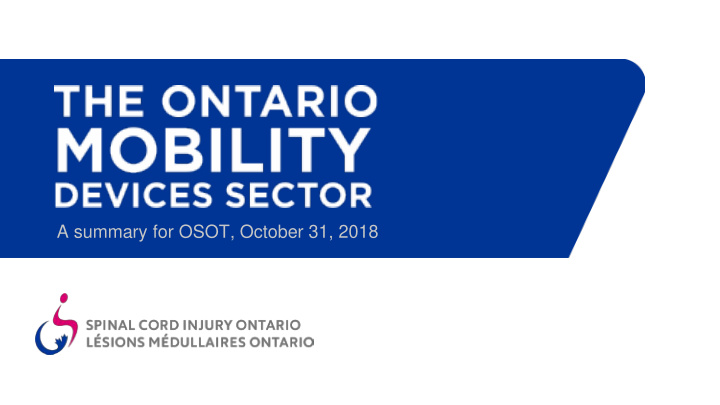



A summary for OSOT, October 31, 2018
OUTLINE 1. SCIO Programs & Services 2. Background a. Spinal cord injuries b. Importance of mobility devices c. The ADP 3. The Review - Methods a. Jurisdictional Scan, Focus Groups, Surveys b. The three stakeholder groups, and why they matter 4. Challenges and Recommendations a. Key challenges facing the mobility devices sector
OUR SERVICES • Service Co-ordination • Peer Support • Attendant Services • Employment Services • Advocacy • Knowledge Exchange 3
BACKGROUND SPINAL CORD INJURIES AS OF 2010 THERE WERE THERE ARE AN AVERAGE OF BY THE YEAR 2030 THIS AN ESTIMATED 4,259 NUMBER IS EXPECTED 85,556 TO GROW TO 121,000 PEOPLE LIVING WITH SPINAL NEW CASES OF SPINAL CORD CORD INJURY INJURIES EACH YEAR. IN CANADA.
BACKGROUND MOBILITY DEVICES • The average lifetime economic cost of an individual with a spinal cord injury is as high as $3 million , and the total cost of all new cases annually is $2.67 billion. • Access to mobility and other assistive devices is critically important to the well-being of people who have sustained a spinal cord injury. • Improving people’s mobility leads to improved physical and mental well-being , and an overall higher quality of life. • When provision of mobility devices is inadequate, people with spinal cord injuries and other disabilities may not have access to the variety and quality of devices that they require.
BACKGROUND THE ONTARIO ASSISTIVE DEVICES PROGRAM • The Ontario Assistive Devices Program (ADP) is Government of Ontario’s primary program for supporting persons with disabilities in acquiring an assistive device. • The ADP funds up to 75% of the costs of a new device, with the remaining 25% paid by the consumer. • Individuals seeking to access the ADP for a mobility device must receive medical authorization from a program authorizer. Once medical authorization has been received, the consumer can seek out an ADP-authorized mobility device vendor from which they can purchase their device.
THE REVIEW METHODOLOGY SCIO approached the Public Good Initiative to conduct a review of Ontario’s mobility device sector and its ability to prescribe and provide devices to those who need them. The Review includes: • The views of the three stakeholder groups within the ADP and the mobility device sector; ADP authorizers, ADP- authorized mobility device vendors, and consumers of mobility devices. • First-hand accounts from the stakeholder groups to ensure the review reflected varied and nuanced opinions. • A jurisdictional scan to identify mobility device provision systems across the world, as well as interviews and surveys with the stakeholder groups.
AFFORDABILITY CHALLENGES • People with spinal cord injuries and other disabilities struggle to afford the ADP’s 25% co-payment fee. • The ADP only provides funding for a single mobility device, but health care professionals recommend access to both power and manual devices. • A number of essential assistive devices remain ineligible for funding through the ADP. These devices are critical to an individual’s well-being. • Mobility device repairs and regular upkeep costs remain unfunded by the ADP. Over time, these costs present a burden for owners of mobility devices.
AFFORDABILITY RECOMMENDATIONS INCREASE BASE FUNDING FOR THE ADP THE ADP PROVIDE ADP COVERAGE BE EXPANDED 90% FUNDING FOR A SECONDARY TO INCLUDE A GREATER MOBILITY DEVICE AT A RATE OF VARIETY OF ESSENTIAL 75% EQUIPMENT OF THE COSTS AND COSTS OF INSPECTIONS, UPKEEP AND REPAIRS. PEOPLE LIVING WITH SPINAL CORD INJURY.
HEALTH CARE CHALLENGES • As Ontario’s health care system continues to deal with increased demand, patients recovering from spinal cord injuries are being discharged sooner than ever before. This means patients will be prescribed a mobility device at time of discharge of which they pay at least 25% of the total cost , that may no longer be usable within a few months, as their condition progresses beyond necessity of the device. • ADP program authorizers report they have limited opportunity to follow up with their patients following discharge and assess the appropriateness of their devices in their own homes.
HEALTH CARE RECOMMENDATIONS PROVIDE MORE OPPORTUNITIES PROVIDE GREATER TO ASSESS ACCESS TO REHABILITATION PEOPLE SERVICES IN THEIR OWN HOMES TO ENSURE FOR INDIVIDUALS RECOVERING THE PRESCRIBED DEVICE SUITS FROM SPINAL CORD INJURY. THEIR NEEDS.
REGULATION & TRAINING CHALLENGES • People with spinal cord injuries and other disabilities were dissatisfied with the customer service (not given adequate opportunity to trial a mobility device for daily use in the own home) when purchasing a mobility device from and ADP-authorized vendor. • Ontario’s ADP suffers from a lack of available program authorizers. There are too few opportunities for prospective ADP program authorizers to be training in the proper assessment and prescription of mobility devices. • A lack of regulation of the mobility device vendor sector may contribute to the unsatisfactory customer service experienced when purchasing a mobility device.
REGULATION & TRAINING RECOMMENDATIONS IDENTIFY OPPORTUNITIES VENDORS BE REQUIRED INCREASE THE TO EXPAND TO PROVIDE AN APPROPRIATE CREDENTIALS MENTORING TRIAL DEVICE REQUIRED OPPORTUNITIES FOR AN ADEQUATE FOR MEMBERS TO TO BECOME AN ADP- AMOUNT OF TIME. BECOME MOBILITY AUTHORIZED MOBILITY DEVICE DEVICE AUTHORIZERS WITHIN VENDOR. THE ADP.
SCIO greatly values our partnerships with OTs and other health care professionals. Together, we can support, serve and advocate for and with people with spinal cord injuries.
THANK YOU petera@sciontario.org
Recommend
More recommend